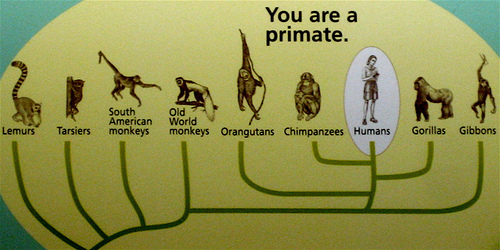Human Evolution theory
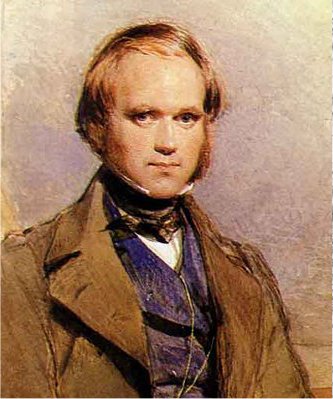 Charles Darwin, (pictured - left - as a young man), whom many people consider to have been the originator of Evolutionary Theory
as applicable both to animal life generally and to Humanity in particular, actually shares with Alfred Russel Wallace the attribution for
independent development of Modern Evolutionary Theory. Neither of them were to be the first
to go so far as to explicitly take the step of subjecting Mankind to Evolutionary Theory speculations.
Charles Darwin, (pictured - left - as a young man), whom many people consider to have been the originator of Evolutionary Theory
as applicable both to animal life generally and to Humanity in particular, actually shares with Alfred Russel Wallace the attribution for
independent development of Modern Evolutionary Theory. Neither of them were to be the first
to go so far as to explicitly take the step of subjecting Mankind to Evolutionary Theory speculations.Darwin, born in 1809 into quite a comfortable background as the son of a well-regarded and prosperous doctor based in Shrewsbury, England, was an avid beetle collector in his teenage-years who abandoned medical studies after being appalled by the sufferings of patients undergoing the surgical techniques of the day, (without relief from anaesthetics), and then entered Christ's College, Cambridge, with the view of becoming a country parson. In those times it was quite accepted for clergymen to interest themselves in Natural History as part of God's creation.
Whilst at Cambridge his interest in Natural History led to informal contacts with professors of Botany and Geology and, through these contacts, to an invitation to join HMS Beagle on an exploratory voyage to South America and beyond as a geologist.
This invitation arrived just as Darwin had completed his university degree course and effectively postponed his actually becoming ordained as a clergyman.
During this voyaging on HMS Beagle (1831-1836), however, Darwin lost his faith and also emerged from it as a recognised man of science due to the wider publication of certain learned papers he had sent home to friends and acquaintances. The Beagle voyage gave Darwin a wide background in Natural History.
As early as July 1837 Darwin opened a notebook to record his thoughts on "that mystery of mysteries - the origin of species" as this entry from his diary relates:-
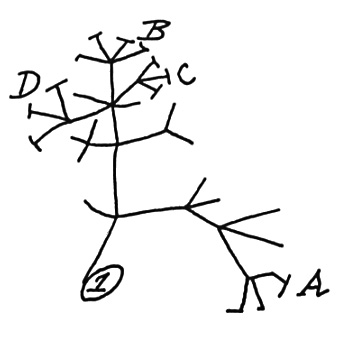 Charles Darwin's early evolutionary theory insight of how a branching tree-like genus of related species might
originate by divergence from a starting point (1) to effectively establish related species at such notional points as A, B, C and D.
Charles Darwin's early evolutionary theory insight of how a branching tree-like genus of related species might
originate by divergence from a starting point (1) to effectively establish related species at such notional points as A, B, C and D.
There is an accompanying text annotation that reads:-
I think
Case must be that one generation then should be as many living as now. To do this & to have many species in same genus (as is) requires extinction.
Thus between A & B immense gap of relation. C & B the finest gradation, B & D rather greater distinction. Thus genera would be formed. - bearing relation (page 36 ends - page 37 begins) to ancient types with several extinct forms.
From Darwin's notebook B now stored in Cambridge University library.
Darwin had grown up in and, despite his own skepticism after returning from his voyages, continued to live in a society that generally accepted biblical explanations of creation whereby the Earth and all of its unchanging, immutable, life forms - including Human Beings - were, as they were and as they ever had been, as a result of Original Acts of Divine Creation.
Against this pervasive cultural background, in a confidential letter of 11 January 1844 to a fellow scientist named Joseph Hooker, Darwin wrote that:-
(Lamarck's approach effectively held that species needed or wanted to achieve swifter gaits, or stronger muscles, or whatever, to gain food and such adaptations followed on from those needs or wants.
Darwin's approach ultimately held that slight physical variations occur within species and that such variations, particulaly those that promote more effective winning of food for survival, allow those individuals that happen to possess them more success in terms of survival and hence breeding opportunity - passing favourable variations or modifications on to their own descendants).
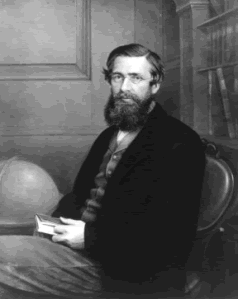 A professional collector of biological specimens named Alfred Russel Wallace, (pictured right), was acquainted with Charles Darwin and
had forwarded specimens he had collected to Darwin. Darwin was a great writer of
letters and had corresponded intermittently with Wallace.
A professional collector of biological specimens named Alfred Russel Wallace, (pictured right), was acquainted with Charles Darwin and
had forwarded specimens he had collected to Darwin. Darwin was a great writer of
letters and had corresponded intermittently with Wallace.
And so it was that Wallace, who had independently arrived at an evolutionary theory in 1858 whilst he was laid up with a malarial fever at Ternate, in the Celebes Islands where he had been collecting biological specimens, sent a twenty page long memoir about this evolutionary theory he had devised to the influential expert amateur naturalist Charles Darwin, which arrived at Darwin's house in Kent in June 1858.
In a covering letter Wallace asked that Darwin forward the memoir to a famous scientist named Sir Charles Lyell, if Darwin thought the content merited Lyell's attention.
Wallace had concluded that species throw up occasional variations in form which may decisively benefit the individuals who carry that variation. He, like Darwin years earlier, had been struck by a viewpoint attributable to Thomas Malthus, which held that populations will tend to outstrip the food supply naturally available to them. Again, like Darwin, Wallace envisaged a relentless favouring in terms of short term survival and longer term breeding opportunities being naturally bestowed on those individuals that bore variant traits that favoured the winning of scarce food for their day-to-day sustenance.
Darwin subsequently sent Wallace's manuscript to Lyell; with his own covering letter of 18th June 1858 that included the following sentences:-
Some year or so ago, you recommended me to read a paper by Wallace in the Annals, which had interested you & as I was writing to him, I knew this would please him much, so I told him. He has to day sent me the enclosed & asked me to forward it to you. It seems to me well worth reading. Your words have come true with a vengeance that I shd. be forestalled. You said this when I explained to you here very briefly my views of "Natural Selection" depending on the Struggle for existence. - I never saw a more striking coincidence. If Wallace had my manuscript sketch written out in 1842 he could not have made a better short abstract! Even his terms now stand as Heads of my Chapters.
Please return me the manuscript which he does not say he wishes me to publish; but I shall of course at once write & offer to send to any Journal. So all my originality, whatever it may amount to, will be smashed. Though my Book, if it will ever have any value, will not be deteriorated; as all the labour consists in the application of the theory.
I hope you will approve of Wallace's sketch, that I may tell him what you say.
Several days later Darwin again wrote to Sir Charles Lyell:-
Neither Wallace nor Charles Darwin were present at the meeting of the Linnaean Society in July 1858 when papers attributable to each were brought to the attention of the wider scientific community.
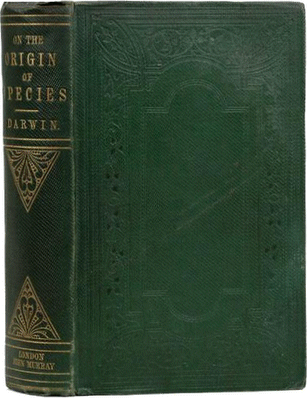 Following on from Wallace's approach of 1858 Darwin made
efforts to draw his notes together into a work intended for
publication. That work was prepared and published under the title
On the
Origin of Species by Means of Natural Selection, or the Preservation of Favoured Races in the Struggle for Life was first published on 24 November 1859.
Following on from Wallace's approach of 1858 Darwin made
efforts to draw his notes together into a work intended for
publication. That work was prepared and published under the title
On the
Origin of Species by Means of Natural Selection, or the Preservation of Favoured Races in the Struggle for Life was first published on 24 November 1859.
There were only 1,250 copies prepared in this first edition, and Darwin had suggested to his publisher that even this would be too many for what he presumed to be a limited and specialised scientific market.
Although the book was priced at fourteen shillings - more than a week's wages for a labouring man and hence beyond most persons convenient means - and its content was slightly technical this edition sold out to the book trade on the day of publication.
A second edition of 3,000 copies was issued some two months later.
Few books have had such a profound and far-reaching impact on Human Society across the world.
In this work Darwin concentrated on "Descent with modification" as having been extremely influential in giving rise to new species of animal life generally and with no particular focus on Humanity. Darwin work suggested that there had been an initial creation but with many subsequent evolutionary modifications over vast periods of time. Perhaps the most explicit mention of humans as being themselves subject to evolutionary processes occurs in this passage from one of the closing paragraphs of Origin of Species.
In the distant future I see open fields for far more important researches. Psychology will be based on a new foundation, that of the necessary acquirement of each mental power and capacity by gradation. Light will be thrown on the origin of man and his history.
Authors of the highest eminence seem to be fully satisfied with the view that each species has been independently created. To my mind it accords better with what we know of the laws impressed on matter by the Creator, that the production and extinction of the past and present inhabitants of the world should have been due to secondary causes, like those determining the birth and death of the individual. When I view all beings not as special creations, but as the lineal descendants of some few beings which lived long before the first bed of the Silurian system was deposited, they seem to me to become ennobled."
Gradually mankind became the explicit focus of evolutionary theory speculation.
Sir Charles Lyell's The Antiquity of Man was published in early February 1863 and detailed the discoveries of traces of early man dating from the palaeolithic era. In this work which sold well and, "shattered the tacit agreement that mankind should be the sole preserve of theologians and historians". In this work Lyell avoided any definitive statement on human evolution.
Later that year a work entitled Evidence as to Man's Place in Nature by Thomas Henry Huxley was the first book devoted to the topic of human evolution, and discussed much of the anatomical and other evidence for the evolution of man and apes from a common ancestor.
Something of the nature and direction of Huxley's work can prehaps be gauged from the fact that its three chapters were entitled:-
On the Natural History of the Man-Like Apes
On the Relations of Man to the Lower Animals
On Some Fossil Remains of Man
Based on anatomical and other evidence for evolution the book, which achieved a wide readership, put the case that evolutionary theory
applied as fully to human beings as to all other life.
It was in 1871 that Darwin's first explicit work on Human Evolutionary theory was published. In this work, Descent of Man, Darwin attempted
to persuade the reader of mankind's
evolutionary heritage.
Darwin started his Chapter I of this work, itself entitled "The evidence of the descent of man from some lower form"
with the sentence "It is notorious that man is constructed on the same general type or model as other mammals..."
In our own times evolutionary theory is widely applied both to primates and to Human Beings.
For example the following image is attributable to : The National Museum of Natural History - Washington, D.C.
